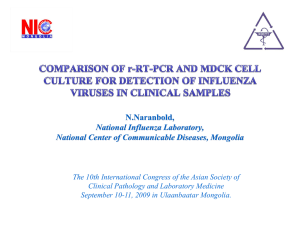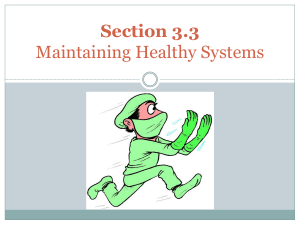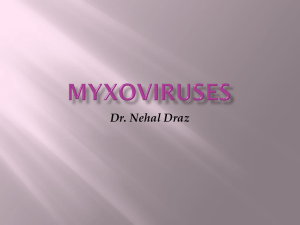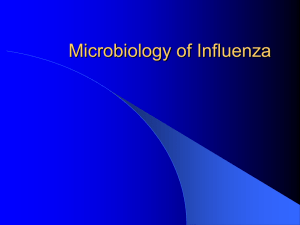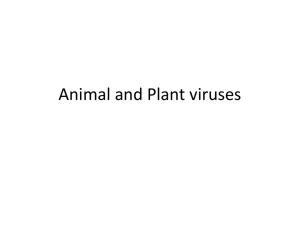Equine influenza remains one of the most important infectious
advertisement
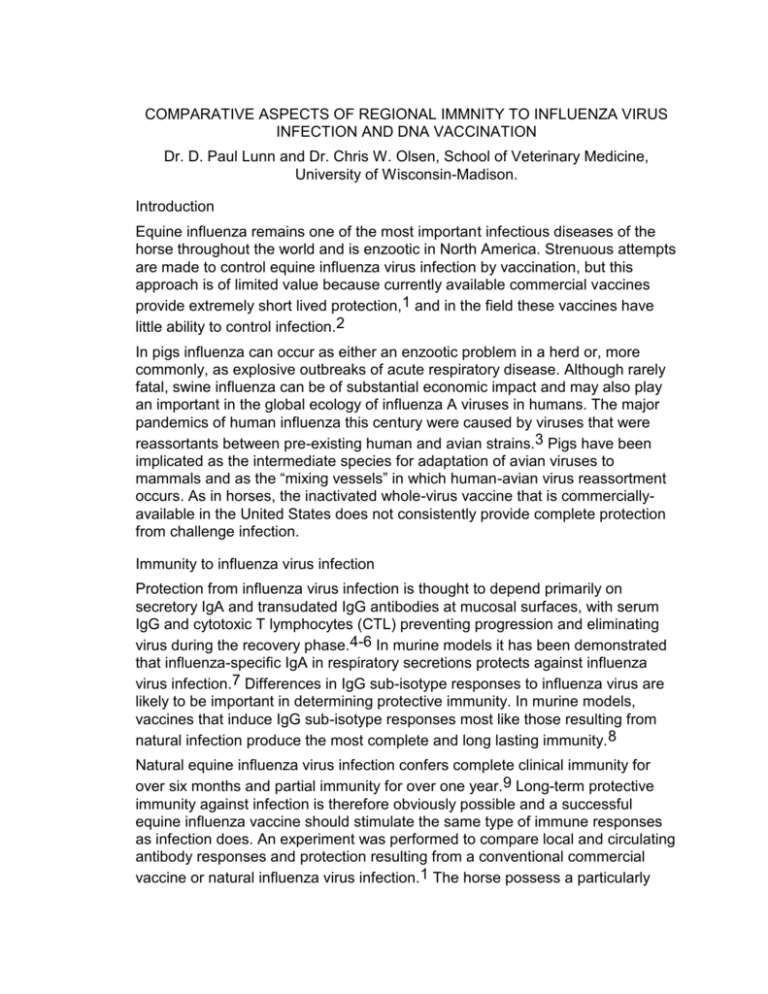
COMPARATIVE ASPECTS OF REGIONAL IMMNITY TO INFLUENZA VIRUS INFECTION AND DNA VACCINATION Dr. D. Paul Lunn and Dr. Chris W. Olsen, School of Veterinary Medicine, University of Wisconsin-Madison. Introduction Equine influenza remains one of the most important infectious diseases of the horse throughout the world and is enzootic in North America. Strenuous attempts are made to control equine influenza virus infection by vaccination, but this approach is of limited value because currently available commercial vaccines provide extremely short lived protection,1 and in the field these vaccines have little ability to control infection.2 In pigs influenza can occur as either an enzootic problem in a herd or, more commonly, as explosive outbreaks of acute respiratory disease. Although rarely fatal, swine influenza can be of substantial economic impact and may also play an important in the global ecology of influenza A viruses in humans. The major pandemics of human influenza this century were caused by viruses that were reassortants between pre-existing human and avian strains.3 Pigs have been implicated as the intermediate species for adaptation of avian viruses to mammals and as the “mixing vessels” in which human-avian virus reassortment occurs. As in horses, the inactivated whole-virus vaccine that is commerciallyavailable in the United States does not consistently provide complete protection from challenge infection. Immunity to influenza virus infection Protection from influenza virus infection is thought to depend primarily on secretory IgA and transudated IgG antibodies at mucosal surfaces, with serum IgG and cytotoxic T lymphocytes (CTL) preventing progression and eliminating virus during the recovery phase.4-6 In murine models it has been demonstrated that influenza-specific IgA in respiratory secretions protects against influenza virus infection.7 Differences in IgG sub-isotype responses to influenza virus are likely to be important in determining protective immunity. In murine models, vaccines that induce IgG sub-isotype responses most like those resulting from natural infection produce the most complete and long lasting immunity. 8 Natural equine influenza virus infection confers complete clinical immunity for over six months and partial immunity for over one year.9 Long-term protective immunity against infection is therefore obviously possible and a successful equine influenza vaccine should stimulate the same type of immune responses as infection does. An experiment was performed to compare local and circulating antibody responses and protection resulting from a conventional commercial vaccine or natural influenza virus infection.1 The horse possess a particularly complex array of immunoglobulin isotypes, with four sub-isotypes of IgG: IgGa, IgGb, IgGc, and IgG(T), in addition to the other immunoglobulin isotypes. It was found that 3 months after administration of two dose of a conventional vaccine, ponies were left unprotected when subjected to a challenge infection. In contrast, 3 months after being given an initial influenza virus infection, ponies were completely immune to a repeat challenge infection. A critical difference between natural infection and vaccination was that infection induced high levels of IgA in nasal mucosal secretions whereas vaccination induced no IgA antibodies. In addition there were marked differences in the isotypes of IgG induced by infection compared to vaccination, with natural infection inducing IgGa and IgGb responses and conventional vaccines inducing IgG(T) responses. In the horse the IgGa and IgGb sub-isotypes are capable of mediating important anti-viral activities such as complement fixation and antibody-dependent cellular cytotoxicity, while IgG(T) responses can actually inhibit complement fixation. Overall there is clearly a need for vaccines better able to induce protective components of the immune response. DNA vaccines Current active vaccination strategies can be broadly divided into the administration of “live”, “dead” and DNA vaccines, and these approaches have been recently and extensively reviewed.10-12 Live vaccines include attenuated microbes and recombinant vaccines that utilize a living vector, while dead vaccines include killed whole pathogens, soluble pathogen subunits or protein subunits. Immunization based on administration of plasmid DNA (variously termed “genetic, “nucleic acid” or “DNA” immunization) is a radically different form of vaccination that enjoys many of the immunological and safety advantages of both live and dead vaccines. DNA vaccination results in the in vivo synthesis of antigenic proteins in a manner identical to that occurring in natural infection.13 This endogenous production results in presentation of antigens by MHC I and presentation to CD8+ T-cytotoxic lymphocytes, and uptake and presentation of soluble proteins by MHC II to CD4+ T-helper lymphocytes. As a result DNA vaccination has been shown to induce both potent CTL and antibody responses. To date no undesirable side effects have been associated with the use of DNA vaccination. Overall DNA vaccines can deliver the immunogenic advantages of live vaccines but at a low cost and with minimal safety concerns. The intense scientific interest in DNA vaccination can be gauged by visiting the World Wide Web site maintained at http://www.genweb.eom/Dnavax/dnavax.html. Influenza virus has been used extensively as a model pathogen in DNA vaccine studies in mice, chickens, ferrets, pigs, horses and non-human primates, and clinical trials of DNA-based influenza virus vaccines are underway in humans. Our studies have focused on gene gun delivery of DNA vaccines against equine and swine influenza viruses in mice, ponies and pigs, including studies employing co-administration of interleukin-6 DNA or cholera toxin as an approach for modulating and adjuvanting influenza virus hemagglutinin-specific immune responses. The results indicate that gene gun administration of plasmids encoding hemagglutinin genes from influenza viruses is an effective method for priming and/or inducing virus-specific immune responses, and for providing partial to complete protection from challenge infection in mice, ponies and pigs.14-17 In addition, studies of interleukin-6 DNA co-administration in mice clearly demonstrate the potential for this approach to enhance vaccine efficacy and protection.18 Immunoregulatory responses The results of these DNA vaccination experiments demonstrate the capacity of immune responses directed solely against the hemagglutinin protein to protect against influenza virus infection in a number of species. In addition, DNA vaccination also provides a powerful tool for identifying the role of specific immune responses in this protection and studying the regulation of these responses. For example, in horses, DNA vaccination responses are primarily restricted to the IgGa and IgGb sub-isotypes and demosntrate the importance of this phenotype of immune response and its ability to confer protection even in the absence of a primary mucosal IgA response. The regulation of immunity to influenza virus infection can also be characterized in terms of the type of Thelper cell associated with specific immune responses. To date studies in horses using analysis of mRNA production by PCR analysis, and in pigs using ELISPOTS, indicate that systemic IFN-g production characteristic of a T-helper 1 response are sequels to both DNA vaccination or influenza virus infection. These studies and others involving modulation of responses to DNA vaccination by coadministration of cytokine genes or mucosal adjuvants such as cholera toxin are helping to build our understanding of regional respiratory immunity to this important viral pathogen. References 1. Nelson KM, Schram BR, McGregor MW, et al. Local and Systemic IsotypeSpecific Antibody Responses to Equine Influenza Virus Infection versus Conventional Vaccination. Vaccine 1998;16:1306-1313. 2. Morley PS, Townsend HGG, Bodgan JR, et al. Efficacy of a commercial vaccine for preventing disease caused by influenza virus infection in horses. J.Am.Vet.Med.Assoc. 1999;215:61. 3. Webster RG, Bean WJ, Gorman OT, et al. Evolution and ecology of influenza A viruses. Microbial Reviews 1992;56. 4. Tomoda T, Morita H, Kurashige T, et al. Prevention of influenza by the intranasal administration of cold-recombinant, live-attenuated influenza virus vaccine: importance of interferon-gamma production and local IgA response. Vaccine 1995;13:185-190. 5. Underdown BJ, Mestecky J. Mucosal immunoglobulins. In: Ogra PL, Strober W, Mestecky J, McGhee JR, Lamm ME, Bienenstock J, eds. Handbook of Mucosal Immunology. San Diego: Academic Press, Inc., 1994:79-85. 6. Ada GL, Jones PD. The immune response to influenza infection. Current Topics in Microbiology and Immunology 1986;128:1-55. 7. Renegar KB, Small PAJ. Passive transfer of local immunity to influenza virus infection by IgA antibody. J Immunol. 1991;146:1972-1978. 8. Hocart MJ, Mackenzie JS, Stewart GA. The IgG subclass responses induced by wild-type, cold-adapted and purified haemagglutinin from influenza virus A/Queensland/6/72 in CBA/CaH mice. J.Gen.Virol. 1988;69:1873-1882. 9. Hannant D, Mumford JA, Jessett DM. Duration of circulating antibody and immunity following infection with equine influenza virus. Vet.Rec. 1988;122:125128. 10. Ellis RW. New technologies for making vaccines. In: Plotkin SA, Orenstein WA, eds. Vaccines. Philadelphia: W.B. Saunders Company, 1999:881-901. 11. Rabinovich NR, McInnes P, Klein DL, et al. Vaccine technologies: view to the future. Science 1994;265:1401-1404. 12. Ertl HCJ, Xiang Z. Novel vaccine approaches. J.Immunol. 1996;156:35793582. 13. Hassett DE, Whitton JL. DNA immunization. Trends in microbiology 1996;8:307-312. 14. Lunn DP, Olsen CW, Soboll G, et al. Development of Practical DNA Vaccination Strategies for use in Horses. In: Wernery U, Wade JF, Mumford JA, Kaaden O-R, eds. Equine infectious diseases VIII. Proceedings of the Eighth International Conference, Dubai 23rd-26th March, 1998. Newmarket: R & W Publications, 1999:38-43. 15. Lunn DP, Soboll G, Schram BR, et al. Antibody responses to DNA vaccination of horses using the influenza virus hemagglutinin gene. Vaccine 1999;17:2245-2258. 16. Olsen CW, McGregor MW, Dybdahl-Sissoko N, et al. Immunogenicity and efficacy of baculovirus-expressed and DNA-based equine influenza virus hemagglutinin vaccines in mice. Vaccine 1997;15:1149-1156. 17. Macklin MD, McCabe DE, McGregor MW, et al. Immunization of pigs with a particle-mediated DNA vaccine to influenza A protects agianst challenge with homologous virus. J.Virol. 1998;72:1491-1496. 18. Larsen DL, Dybdahl-Sissoko N, McGregor MW, et al. Co-administration of DNA encoding interleukin 6 and hemagglutinin confers protection from influenza virus challenge in mice. J.Virol. 1998;72:1704-1708.

